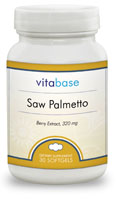| |
Saw palmetto |
|
| Saw palmetto is an extract derived from the deep purple berries of saw palmetto fan palm (Serenoa repens). Saw palmetto serenoa repens is a plant indigenous to the coastal regions of the southern United States and southern California. It is a small palm, normally reaching a height of around 2-4 metres. Saw-palmetto stems may be partially or completely underground and may reach 10 to 15 feet in total length. The leaves are 1-2 m in length, the leaflets 50-100 cm long with prickly sawtooth edges that give the tree its name. Mature leaves have a palmate shape and can range in size from 1.5 to 3 feet wide. The sinuses between the vanes are split towards the outer edge of the leaf. The plant bears white flowers, which develop yellow olive-like berries. Saw-palmetto plants produce one to three prominent clusters of many white flowers, called a spadix. The flowers are yellowish-white, about 5 mm across, produced in dense compound panicles up to 60 cm long. The berry is a single-seeded drupe that is surrounded by a fleshy pulp. |
| |
Active constituents of saw palmetto |
|
| Saw palmetto's active ingredients include fatty acids (capric acid, caprylic acid, lauric acid, myristic acid, palmitic acid, stearic acid, oleic acid, linoleic acid, and linolenic acid), plant sterols (campesterol, stigmasterol, ß-sitosterol, and cycloartenol), volatile oil, steroidal saponins, polyprenic compounds, flavonoids, glucose, galactose, arabinose, uronic acid and other polysaccharides. |
| |
Medicinal uses and health benefits of saw palmetto |
|
|
Saw palmetto is an herb that is most commonly used to treat problems related to benign prostatic hyperplasia (BPH). Benign prostatic hyperplasia is a benign (noncancerous) condition in which an overgrowth of prostate tissue pushes against the urethra and the bladder, blocking the flow of urine. In BPH, the prostate grows larger and presses against the urethra and bladder, interfering with the normal flow of urine. It leads to symptoms of urinary hesitancy, frequent urination, increased risk of urinary tract infections and urinary retention. Benign prostate enlargement is triggered by abnormally high levels of the male hormones testosterone and dihydrotestosterone (DHT) in prostate tissue. Saw palmetto inhibits the conversion of testosterone into dihydrotestosterone (DHT) by decreasing the activity of 5-alpha reductase. Saw palmetto further inhibits binding of DHT to prostatic nuclear receptors. Saw palmetto also inhibits prostaglandin synthesis and thus contributes to the anti-inflammatory effect and reduction of swelling in BPH and prostatitis. Saw palmetto extract may improve symptoms of benign prostatic hypertrophy, such as urine flow and burning with urination, and may reduce the number of times per night that a man with this problem has to urinate. Saw palmetto have mild anti-inflammatory, antiseptic, diuretic, and sedative properties. Saw palmetto has been also used to treat respiratory tract problems, including coughs and colds, bronchitis, and asthma. Saw palmetto is useful for urinary tract infection. |
| |
Dosage and administration of saw palmetto |
|
| Saw palmetto is available in dried berries, tea, powdered capsules, tablets, liquid tinctures, and liposterolic extracts. The most effective preparation is a commercial extract of the berry's oils. Dosages vary depending on the type of saw palmetto used. Oral saw palmetto products should be standardized to contain 85-95% fatty acids and sterols. A typical daily dosage is 1 to 2 grams of crushed saw palmetto berry or 320 milligrams of saw palmetto extract. Tea made from berries may not be effective because the proposed active ingredient does not dissolve in water. |
| |
Side effects, precautions, interactions |
|
Saw palmetto is believed to be quite safe. There are no special precautions associated with taking saw palmetto, even in high doses. Possible but rare side effect may include mild gastrointestinal discomfort, erectile dysfunction, mild headache, dizziness, insomnia, fatigue, depression, stomach upset, breathlessness, fast heart rate, dry mouth, bad breath, nausea, constipation, vomiting, diarrhea, ulcer, liver inflammation, yellowing of the skin (jaundice), rash, loss of libido, urinary tract infection and muscle pain. Because saw palmetto may have hormonal effects, women who are pregnant or who may become pregnant should not take it. Saw palmetto may interfere with hormone-related drugs such as testosterone and estrogen replacements. It may also interact with birth control pills. Saw palmetto may increase the risk of bleeding when taken with products such as ginkgo biloba and garlic. |
|
|
|
|
 Vitabase's Standardized Saw Palmetto Extract is produced by Euromed, a European phytopharmaceutical company. The extract is manufactured under strict European quality control standards without the use of harsh solvents. Like all European herbal extracts, the extraction of Saw Palmetto is regulated to the same high quality control standards as over-the-counter drugs in the U.S. Click here for more information.
Vitabase's Standardized Saw Palmetto Extract is produced by Euromed, a European phytopharmaceutical company. The extract is manufactured under strict European quality control standards without the use of harsh solvents. Like all European herbal extracts, the extraction of Saw Palmetto is regulated to the same high quality control standards as over-the-counter drugs in the U.S. Click here for more information.